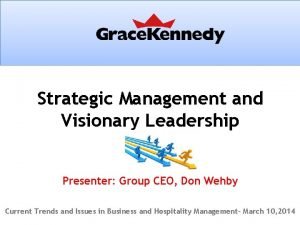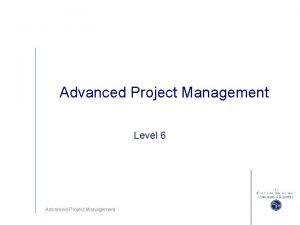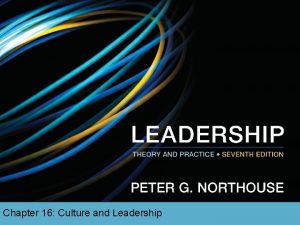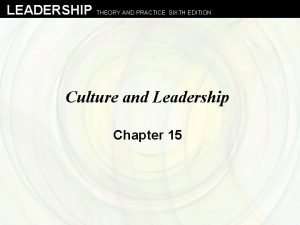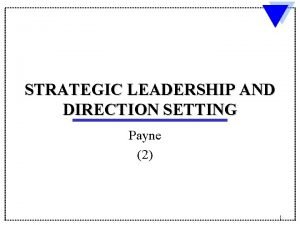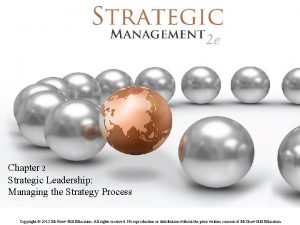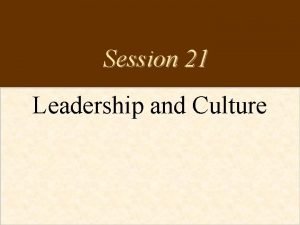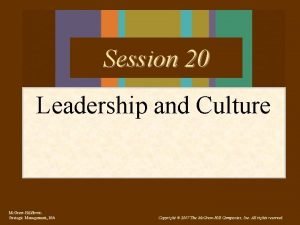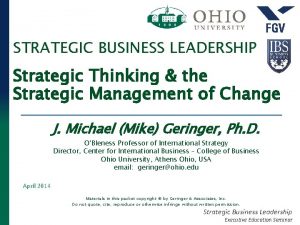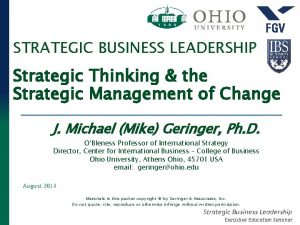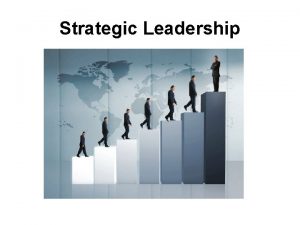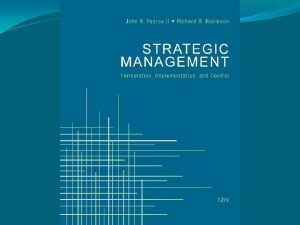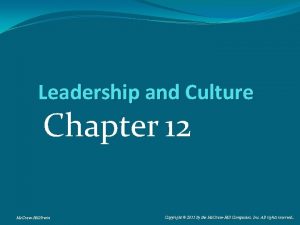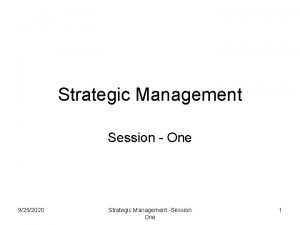Session 20 Leadership and Culture Mc GrawHillIrwin Strategic





















- Slides: 21

Session 20 Leadership and Culture Mc. Graw-Hill/Irwin Strategic Management, 10/e Copyright © 2007 The Mc. Graw-Hill Companies, Inc. All rights reserved.

Learning Objectives 12 -2 1. Explain the relevance of vision and performance in helping leaders clarify their strategic intent 2. Define and illustrate the value of passion and selection/development of new leaders as means to shape their organization’s culture 3. Define and explain what is meant by organizational culture, and how it is created, influenced, and changed 4. Explain two roles organizational leaders have in an organizational culture 5. Describe ways leaders influence organizational culture

Strategic Leadership: Embracing Change • 12 -3 The leadership challenge is to galvanize commitment among people within an organization as well as stakeholders outside the organization to embrace change and implement strategies intended to position the organization to succeed in a vastly different future

12 -4 Clarifying Strategic Intent • • Leaders help their company embrace change by charting strategic intent—a clear sense of where they want to lead the company and what results they expect to achieve Leader’s vision—an articulation of a simple criterion or characterization of what the leader sees the company must become to establish and sustain global leadership

12 -5 “I have vision and the rest of the west wears bifocals” Butch Cassidy circa 1870 http: //www. bing. com/videos/search? q=you+tube+butch+cassidy+vision&qs=n&form=QBVR&pq=you+tube+butch+cassidy+vision&sc=00&sp=-1&sk=#view=detail&mid=88 D 9686 F 5 FAF 797 ADA 98

12 -6 “By the end of this decade I commit this nation to putting a man on the moon” John F. Kennedy 1961

12 -7 th 20 “By the turn of the century there will be more computers than televisions in the U. S. ” ? ?

12 -8 Recruiting and Developing Talented Operational Leadership • The New Leader: global managers, change agents, strategists, motivators, strategic decision makers, innovators, and collaborators if the business is to survive and prosper

12 -9 Organizational Culture • • • Organizational culture is the set of important assumptions (often unstated) that members of an organization share in common Every organization has its own culture: can be functional or dysfunctional. Assumptions become shared assumptions through internalization among an organization’s individual members

12 -10 Attributes of an Org’s Culture • • • Degree of Individual autonomy Organizational Structure: groups/arranges workers Level of Warmth/ Personal Support Willingness of Employees to Identify as Member Performance reward: Meritocracy or Not? Conflict tolerance: Reward Good Tries or Just Performance • Risk tolerance: Ready, fire, aim; Do something even if it’s wrong. At least then we’ll know.

12 -11 Origins of Culture • History • Environment • Staffing • Socialization

Culture and Competitive Advantage Culture Must: Generate Specific Value for the Firm Be Rare Not easily imitable 12 -12

12 -13 Shaping Organizational Culture • • Passion, in a leadership sense, is a highly motivated sense of commitment to what you do and want to do Leaders also use reward systems, symbols, and structure among other means to shape the organization’s culture

12 -14 Primary Embedding Mechanisms • • • What leaders pay attention to, measure and control Leaders reactions to critical incidents/organzational crises Mentoring - Deliberate role modeling, teaching, coaching Criteria for the allocation of rewards and status Criteria for recruitment, selection, promotion, retirement and excommunication

12 -15 Secondary Embedding Mechanisms • • • Organizational design and structure Organizational systems and procedures Design of physical space, facades, buildings Stories about the important events and people Formal statements of organizational philosophy, creeds, charters

12 -16 Mc. Kinsey 7 -S Framework Strategy Structure Systems Shared Values (culture) Style Skills (Organizational) (leadership) Staff (Human Capital)

12 -17 The Role of the Organizational Leader • The leader is the standard bearer, the personification, the ongoing embodiment of the culture, or the new example of what it should become • How the leader behaves and emphasizes those aspects of being a leader become what all the organization sees are “the important things to do and value. ”

Manage the Strategy-Culture Relationship • Link to mission • Maximize synergy • Manage around the culture • Reformulate strategy or culture 12 -18

12 -19 Remember: Culture Eats Strategy for Breakfast!

12 -20 Culture, Structure, Leadership and Reward Systems should be Strategy Based

12 -21 celebrate, point out, document, ritualize, measure and reward behaviors/skills/actions that achieve efficiency, innovation, product quality or customer responsiveness.
 Tirole
Tirole Industrial organization model of above average returns
Industrial organization model of above average returns Cultural aspects of strategy choice
Cultural aspects of strategy choice Visionary leadership and strategic management
Visionary leadership and strategic management Advanced project management and strategic leadership
Advanced project management and strategic leadership Transformational vs transformative leadership
Transformational vs transformative leadership Culture and leadership northouse
Culture and leadership northouse Culture and leadership northouse
Culture and leadership northouse Example of pop culture
Example of pop culture Continuous culture and batch culture
Continuous culture and batch culture Difference between american and indian culture
Difference between american and indian culture Stroke culture method
Stroke culture method Folk culture and popular culture venn diagram
Folk culture and popular culture venn diagram Examples of mass culture
Examples of mass culture Anaerobic media
Anaerobic media Folk culture and popular culture venn diagram
Folk culture and popular culture venn diagram Lawn culture method
Lawn culture method Robertson cooked meat medium
Robertson cooked meat medium Surface culture deep culture and esol
Surface culture deep culture and esol Strategic fit vs strategic intent
Strategic fit vs strategic intent Strategic leadership
Strategic leadership Level 5 pyramid of strategic leadership
Level 5 pyramid of strategic leadership



